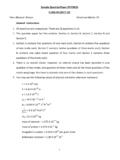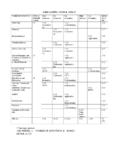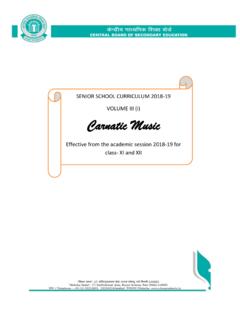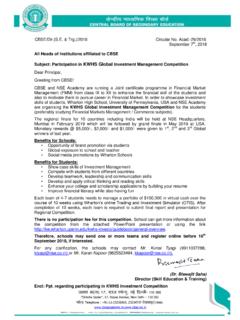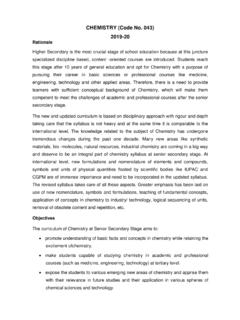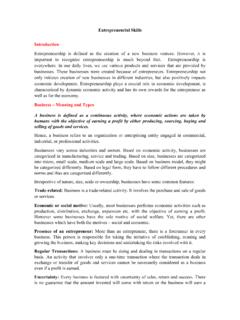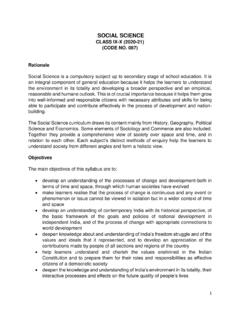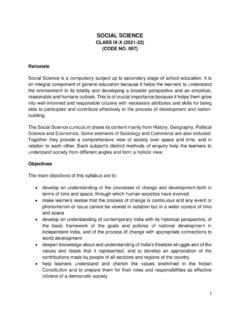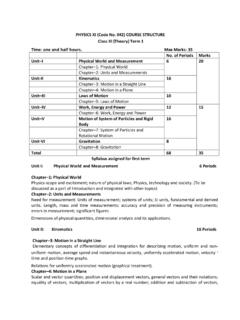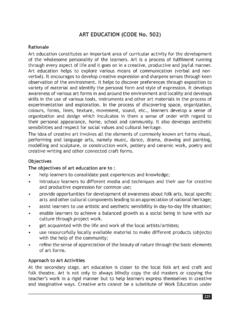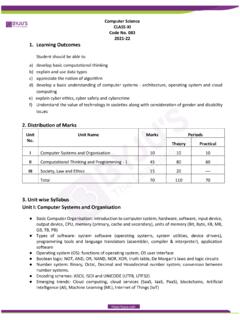Transcription of Learning Outcomes
1 Computer Science CLASS - XI Code No. 083 2021-22 1. Learning Outcomes Student should be able to a) develop basic computational thinking b) explain and use data types c) appreciate the notion of algorithm d) develop a basic understanding of computer systems - architecture, operating system and cloud computing e) explain cyber ethics, cyber safety and cybercrime f) Understand the value of technology in societies along with consideration of gender and disability issues 2. Distribution of Marks Unit No. Unit Name Marks Periods Theory Practical I Computer Systems and Organisation 10 10 5 II Computational Thinking and Programming - 1 45 50 35 III Society, Law and Ethics 15 20 ---- Total 70 80 40 Term-1 Term-2 Marks Marks I Computer Systems and Organisation 10 --- II Computational Thinking and Programming - 1 25 20 III Society, Law and Ethics --- 15 35 35 3. Unit wise Syllabus TERM 1: Unit I: Computer Systems and Organisation Basic Computer Organisation: Introduction to computer system, hardware, software, input device, output device, CPU, memory (primary, cache and secondary), units of memory (Bit, Byte, KB, MB, GB, TB, PB) Types of software: system software (operating systems, system utilities, device drivers), programming tools and language translators (assembler, compiler & interpreter), application software Operating system (OS): functions of operating system, OS user interface Boolean logic: NOT, AND, OR, NAND, NOR, XOR, truth table, De Morgan s laws and logic circuits Number system: Binary, Octal, Decimal and Hexadecimal number system; conversion between number systems.
2 Encoding schemes: ascii , ISCII and UNICODE (UTF8, UTF32) Unit II: Computational Thinking and Programming 1 Introduction to problem solving: Steps for problem solving (analysing the problem, developing an algorithm, coding, testing and debugging). representation of algorithms using flow chart and pseudo code, decomposition Familiarization with the basics of Python programming: Introduction to Python, features of Python, executing a simple "hello world" program, execution modes: interactive mode and script mode, Python character set, Python tokens (keyword, identifier, literal, operator, punctuator), variables, concept of l-value and r-value, use of comments Knowledge of data types: number (integer, floating point, complex), boolean, sequence (string, list, tuple), none, mapping (dictionary), mutable and immutable data types Operators: arithmetic operators, relational operators, logical operators, assignment operator, augmented assignment operators, identity operators (is, is not), membership operators (in, not in) Expressions, statement, type conversion & input/output.
3 Precedence of operators, expression, evaluation of expression, python statement, type conversion (explicit & implicit conversion ), accepting data as input from the console and displaying output Errors: syntax errors, logical errors, runtime errors Flow of control: introduction, use of indentation, sequential flow, conditional and iterative flow control Conditional statements: if, if-else, if-elif-else, flowcharts, simple programs: : absolute value, sort 3 numbers and divisibility of a number Iterative statements: for loop, range function, while loop, flowcharts, break and continue statements, nested loops, suggested programs: generating pattern, summation of series, finding the factorial of a positive number etc Strings: introduction, indexing, string operations (concatenation, repetition, membership & slicing), traversing a string using loops, built-in functions: len(), capitalize(), title(), lower(), upper(), count(), find(), index(), endswith(), startswith(), isalnum(), isalpha(), isdigit(), islower(), isupper(), isspace(), lstrip(), rstrip(), strip(), replace(), join(), partition(), split() TERM 2: Unit II: Computational Thinking and Programming 1 Lists: introduction, indexing, list operations (concatenation, repetition, membership & slicing), traversing a list using loops, built-in functions: len(), list(), append(), extend(), insert(), count(), index(), remove(), pop(), reverse(), sort(), sorted(), min(), max(), sum(); nested lists, suggested programs: finding the maximum, minimum, mean of numeric values stored in a list; linear search on list of numbers and counting the frequency of elements in a list Tuples: introduction, indexing, tuple operations (concatenation, repetition, membership & slicing), built-in functions: len(), tuple(), count(), index(), sorted(), min(), max(), sum().
4 Tuple assignment, nested tuple, suggested programs: finding the minimum, maximum, mean of values stored in a tuple; linear search on a tuple of numbers, counting the frequency of elements in a tuple Dictionary: introduction, accessing items in a dictionary using keys, mutability of dictionary (adding a new item, modifying an existing item), traversing a dictionary, built-in functions: len(), dict(), keys(), values(), items(), get(), update(), del(), clear(), fromkeys(), copy(), pop(), popitem(), setdefault(), max(), min(), count(), sorted(), copy(); suggested programs : count the number of times a character appears in a given string using a dictionary, create a dictionary with names of employees, their salary and access them Introduction to Python modules: Importing module using 'import <module>' and using from statement, Importing math module (pi, e, sqrt, ceil, floor, pow, fabs, sin, cos, tan); random module (random, randint, randrange), statistics module (mean, median, mode) Unit III: Society, Law and Ethics Digital Footprints Digital society and Netizen: net etiquettes, communication etiquettes, social media etiquettes Data protection: Intellectual Property Right (copyright, patent, trademark), violation of IPR (plagiarism, copyright infringement, trademark infringement), open source softwares and licensing (Creative Commons, GPL and Apache) Cyber-crime: definition, hacking, eavesdropping, phishing and fraud emails, ransomware, preventing cyber crime Cyber safety: safely browsing the web, identity protection, confidentiality, cyber trolls and bullying.
5 Safely accessing web sites: malware, viruses, Trojans, adware E-waste management: proper disposal of used electronic gadgets Indian Information Technology Act (IT Act) Technology & Society: Gender and disability issues while teaching and using computers 4. Practical Marks (Total=30) Term-1 (15 Marks) Term-2 (15 Marks) 1. Python program 12 6 6 2. Report file: Minimum 20 Python programs Term- 1 : Minimum 10 programs based on Term 1 syllabus Term- 2 : Minimum 10 programs based on Term 2 syllabus 7 4 3 Viva voce 3 2 1 3. Project + Viva voce Term 1 : Synopsis of the project to be submitted by the students (documentation only) Term - 2 : Final coding + Viva voce (Student will be allowed to modify their Term 1 document and submit the final executable code.) 8 3 5 5. Suggested Practical List Term - 1 Input a welcome message and display it. Input two numbers and display the larger / smaller number. Input three numbers and display the largest / smallest number.
6 Generate the following patterns using nested loop. Pattern-1 Pattern-2 Pattern-3 * ** ** ** ** 1 2 3 4 5 1 2 3 4 1 2 3 1 2 1 A AB ABC ABCD ABCDE Write a program to input the value of x and n and print the sum of the following series: o 1+x+x2+x3+x4+.. xn o 1-x+x2-x3+x4 .. xn o x - x2 + x3 - x4 + .. xn 2 3 4 n o x + x2- x3+ x4 .. xn 2! 3! 4! n! Determine whether a number is a perfect number, an armstrong number or a palindrome. Input a number and check if the number is a prime or composite number. Display the terms of a Fibonacci series. Compute the greatest common divisor and least common multiple of two integers. Count and display the number of vowels, consonants, uppercase, lowercase characters in string. Input a string and determine whether it is a palindrome or not; convert the case of characters in a string. Term - 2 Find the largest/smallest number in a list/tuple Input a list of numbers and swap elements at the even location with the elements at the odd location.
7 Input a list/tuple of elements, search for a given element in the list/tuple. Input a list of numbers and find the smallest and largest number from the list. Create a dictionary with the roll number, name and marks of n students in a class and display the names of students who have scored marks above 75. 6. Suggested Reading Material NCERT Textbook for COMPUTER SCIENCE (Class XI) Support Materials on the CBSE website. Computer Science CLASS-XII Code No. 083 2021-22 1. Prerequisites Computer Science- Class XI 2. Learning Outcomes Student should be able to a) apply the concept of function. b) explain and use the concept of file handling. c) use basic data structure: Stacks. d) explain basics of computer networks. e) use Database concepts, SQL along with connectivity between Python and SQL. 3. Distribution of Marks: Unit No. Unit Name Marks Periods Theory Practical I Computational Thinking and Programming - 2 40 50 25 II Computer Networks 10 10 --- III Database Management 20 20 15 Total 70 80 40 Unit No Unit Name Term-1 Term-2 I Computational Thinking and Programming - 2 35 5 II Computer Networks --- 10 III Database Management --- 20 Total 35 35 4.
8 Unit wise Syllabus TERM 1: Unit I: Computational Thinking and Programming 2 Revision of Python topics covered in Class XI. Functions: types of function (built-in functions, functions defined in module, user defined functions), creating user defined function, arguments and parameters, default parameters, positional parameters, function returning value(s), flow of execution, scope of a variable (global scope, local scope) Introduction to files, types of files (Text file, Binary file, CSV file), relative and absolute paths Text file: opening a text file, text file open modes (r, r+, w, w+, a, a+), closing a text file, opening a file using with clause, writing/appending data to a text file using write() and writelines(), reading from a text file using read(), readline() and readlines(), seek and tell methods, manipulation of data in a text file Binary file: basic operations on a binary file: open using file open modes (rb, rb+, wb, wb+, ab, ab+), close a binary file, import pickle module, dump() and load() method, read, write/create, search, append and update operations in a binary file CSV file: import csv module, open / close csv file, write into a csv file using () and read from a csv file using ( ) TERM 2: Unit I: Computational Thinking and Programming 2 Data Structure: Stack, operations on stack (push & pop), implementation of stack using list.
9 Unit II: Computer Networks Evolution of networking: introduction to computer networks, evolution of networking (ARPANET, NSFNET, INTERNET) Data communication terminologies: concept of communication, components of data communication (sender, receiver, message, communication media, protocols), measuring capacity of communication media (bandwidth, data transfer rate), IP address, switching techniques (Circuit switching, Packet switching) Transmission media: Wired communication media (Twisted pair cable, Co-axial cable, Fiber-optic cable), Wireless media (Radio waves, Micro waves, Infrared waves Network devices (Modem, Ethernet card, RJ45, Repeater, Hub, Switch, Router, Gateway, WIFI card) Network topologies and Network types: types of networks (PAN, LAN, MAN, WAN), networking topologies (Bus, Star, Tree) Network protocol: HTTP, FTP, PPP, SMTP, TCP/IP, POP3, HTTPS, TELNET, VoIP Introduction to web services: WWW, Hyper Text Markup Language (HTML), Extensible Markup Language (XML), domain names, URL, website, web browser, web servers, web hosting Unit III: Database Management Database concepts: introduction to database concepts and its need Relational data model: relation, attribute, tuple, domain, degree, cardinality, keys (candidate key, primary key, alternate key, foreign key) Structured Query Language.)
10 Introduction, Data Definition Language and Data Manipulation Language, data type (char(n), varchar(n), int, float, date), constraints (not null, unique, primary key), create database, use database, show databases, drop database, show tables, create table, describe table, alter table (add and remove an attribute, add and remove primary key), drop table, insert, delete, select, operators (mathematical, relational and logical), aliasing, distinct clause, where clause, in, between, order by, meaning of null, is null, is not null, like, update command, delete command Aggregate functions (max, min, avg, sum, count), group by, having clause, joins : Cartesian product on two tables, equi-join and natural join Interface of python with an SQL database: connecting SQL with Python, performing insert, update, delete queries using cursor, display data by using fetchone(), fetchall(), rowcount, creating database connectivity applications 5.
